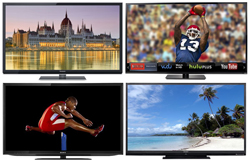
Question:
We are finally going to pull the trigger and get an LED/LCD flat panel. Bye-bye CRT! We’re looking at getting a 60-incher, and our budget is about $1500. Do you have any recommendations? I’m also wondering if we should look for good deals in the holiday shopping season.
Vanessa LaFleur
Hudson, WI
Answer:
Welcome to the modern TV world! There are plenty of good deals on 60-inch flat panels, especially now during the holiday shopping season.
But before I get to that, are you sure you want an LED/LCD TV? If you can watch the new set with relatively low ambient light in the room—that is, if you watch mostly at night or you can block the light from windows—I generally recommend plasma over LED/LCD for a better, more natural picture quality that has none of the drawbacks that LED/LCD TVs strive to overcome.
What are these drawbacks? First, there’s motion blur, in which objects in motion appear more blurry than they do on a plasma. LED/LCD TVs try to overcome this by flashing their backlight in sync with the video frames. Also, sets with 120Hz or 240Hz refresh rates do something called frame interpolation, in which new video frames are synthesized between the real frames. This does sharpen motion detail, but it also creates an artifact called “the soap-opera effect,” because the process makes movies look like soap-opera video.
Then there’s black level—the depth of black the set can reproduce. Traditionally, LCD TVs have relatively high black levels, making the picture look washed out. LEDs can be dynamically controlled so dark scenes look darker, especially in sets with an array of LEDs behind the screen that implement a feature called “local dimming.” In this process, the LEDs behind dark parts of the picture are dimmed while LEDs behind bright portions of the image are brightened. This works pretty well, but TVs with full-array LED backlights and local dimming are very expensive, way outside your budget.
Another problem with most LED/LCD TVs is that the LEDs are mounted at the edges of the screen rather than behind it. The result is uneven illumination, which is especially evident in dark scenes.
Finally, the picture quality of all LCD TVs changes at different viewing angles, and there’s not much that can be done about it. As you move from being directly in front of the center of the screen, the blacks get lighter and the colors change, which is not good for people watching from off to the side. LCDs that use IPS (in-plane switching) panels, such as those from LG, Panasonic, and Vizio, have better off-axis picture quality than those that use VA (vertical alignment) panels, such as those from Samsung and Sony. But VA panels typically have better blacks.
On the other hand, if you watch a lot during the day and can’t block light from the windows, an LED/LCD is probably better, because it’s generally brighter than a plasma. Also, it’s likely to have a matte-finish screen, which rejects reflections better than a plasma’s shiny screen. And plasmas generally consume more electrical power than LED/LCDs.
Let’s start with plasma TVs. If you want 3D and “smart TV” functionality (direct access to online content from the likes of Netflix and YouTube), I recommend the Panasonic TC-P60ST50 (pictured in the upper left above). It lists for $2100, but it’s currently selling for $1600 on Amazon. The TC-P60UT50 offers similar performance for less ($1800 list, $1300 street), and the TC-P60U50 ($1100 list, $900 street) has no 3D or smart TV, but neither of those perform as well as the ST50 in a bright room.
If, after reading all of this, you still think an LED/LCD is the best choice for you, there are a few good options. The Vizio E601i-A3 (upper right above) is being hailed as an exceptional value, with a list price of only $1430 and a street price of around $1000. However, Cnet’s review points out that its blacks are not as deep as some competing sets. Other options include the Sony KDL-60EX645 ($2000 list, $1350 at Best Buy, lower left above) and Sharp LC-60LE640U ($1620 list, $1200 at Sears and Best Buy, lower right above).
All three have excellent picture quality but, like all LED edge-lit LCD TVs, they also have some uniformity problems. In addition, the Sharp’s blacks are a bit light, and it doesn’t handle 24fps (frames per second) movie content properly, resulting in a bit of stuttering in certain scenes. The Sony’s blacks can look a bit bluish under lots of light, and its shadow detail (the amount of detail you can see in dark scenes) isn’t as good as it could be.
One final recommendation: the Samsung UN60EH6000 ($2100 list, $1200 at Sears and Target). This LED/LCD uses LEDs behind the screen rather than around the edges, so uniformity is much better than edge-lit models, though this set does not implement local dimming. It has no 3D or smart TV capabilities, and the input complement is rather skimpy with only two HDMI inputs. Also, the LEDs sometimes shut off entirely during a momentary black screen, which can be annoying. Still, I thought the picture quality was quite good overall, and I measured much lower black levels than Cnet did in its review.


